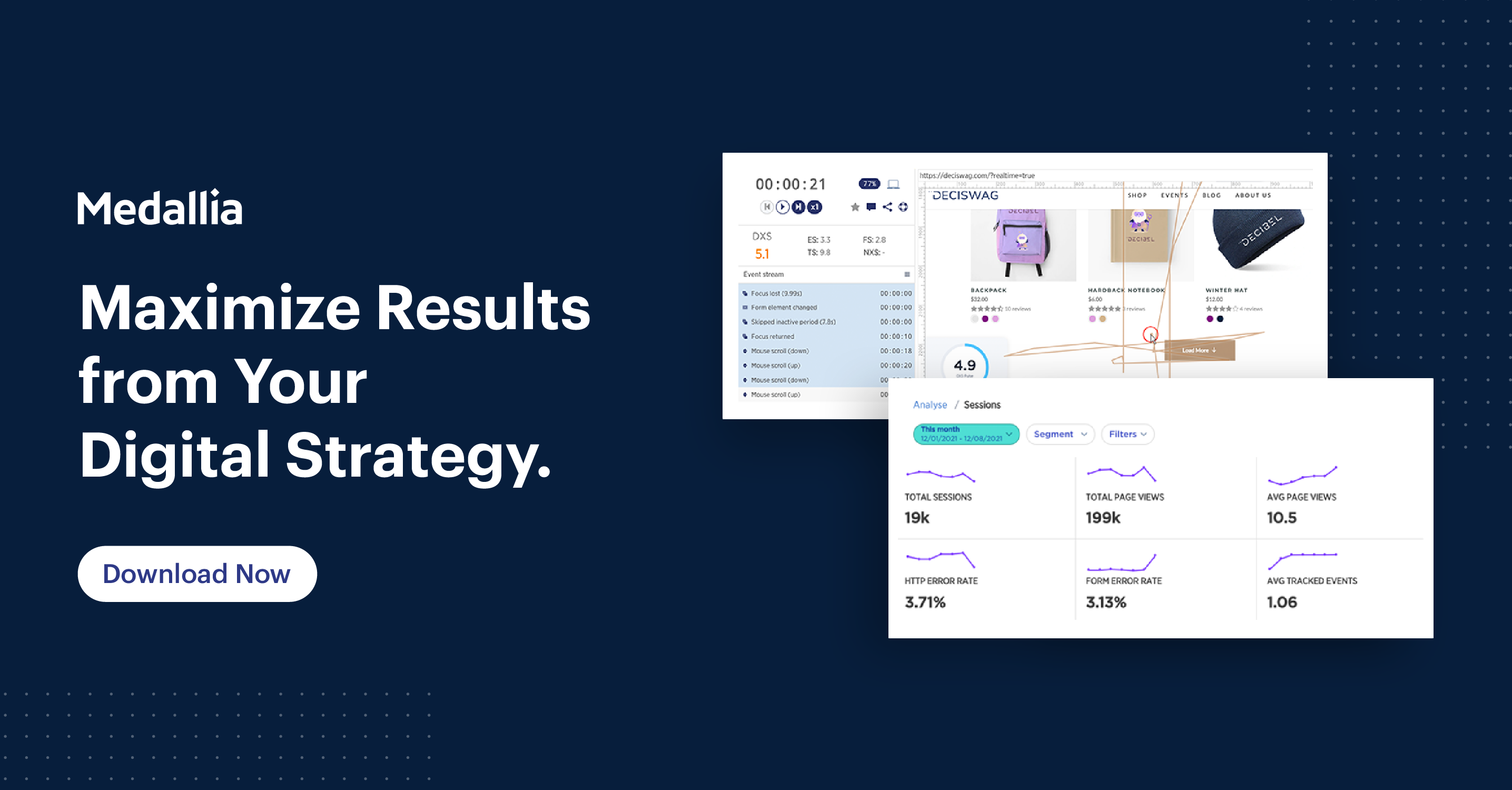Shoppers inside a brick-and-mortar store can touch the fabric, read the tag, try on clothing, and easily find what they need. Stores are well organized and optimized to create an ideal shopping experience.
Ideally, you should strive to bring the same customer experience to your fashion website – as much as possible – if you want to maximize your conversion rates.
How to Increase Conversion Rates on Your Fashion Website with an Optimized Digital Experience
Average conversion rates for apparel vary depending on where the traffic comes from. For example, the average conversion rate for Google Shopping is 2.7%, while Facebook delivers an average of 4.11%.
Your digital experience encompasses every channel: Facebook, chats, landing pages, search, shopping carts, email. A blip or bottleneck anywhere in your digital experience can seriously hold back your overall conversion rate. Plus, customer expectations constantly change, so it’s essential to stay abreast on the latest trends and developments.
You can also use the tips and strategies below to help you create the seamless customer experience your shoppers expect.
1. Create a Frictionless Checkout Process
Before implementing any new personalization tools or features, start with your checkout process and the mobile-first mantra. Americans spend 88% of their mobile time on apps where conversions are 50% lower than desktop.
Optimizing your checkout process for mobile shoppers guarantees a better experience for everyone. Make sure you’re offering a guest checkout option – don’t force shoppers to register an account to complete a purchase.
Keep in mind that many shoppers will add items to their cart from a mobile device but log onto a desktop to complete their purchase. In fact, a third of all retail transactions take place across at least two devices. Use handoff features to ensure any products remain in their cart across multiple devices. Companies that prioritize the omnichannel experience with features like this enjoy 89% retention rates on average compared to 33% for those that don’t.
Sometimes, you can’t be sure exactly where things go wrong in your checkout process. LEGO used real-time heatmaps and session replay quantifiable data to figure out exactly what was causing their checkout bottlenecks.
2. Offer Virtual Try-Ons to Increase Conversion Rates
One of the most significant drawbacks of shopping online is that shoppers can’t try on clothing before purchasing it. If a customer isn’t sure an item will fit or a modern style will flatter their physique, they won’t likely buy it.
You can increase your conversion rates by first offering a seamless and liberal return policy and refund guarantee. However, many customers still won’t want to go through the trouble of returning an item.
Prevent those lost sales by offering virtual try-on features. Zenni, for example, lets customers upload three photos of themselves: head-on and each profile. The eyewear company’s software then transforms the static photos into an interactive graphic where shoppers can test out different frames.
Similar technology could allow shoppers to try on dresses, shirts, shoes, accessories, and more, boosting trust and conversions.
3. Ask Shoppers to Personalize Their Own Experience
Dynamic content offers an excellent solution for hyper-personalizing every shopper’s digital experience. You could start by using cookies or an IP address to personalize shipping rates or products based on a visitor’s location and preferences.
However, you can also ask your shoppers for input as well. Thrive Market starts their website experience by asking shoppers a series of questions about their diet and shopping habits. Your fashion website could follow a similar strategy, asking for shopper input before opening the full site.
You can also personalize based on activity from other channels like email or social media along with prior purchases. Combine data from multiple sources to learn about each customer’s style and shopping habits to offer personalized recommendations on your site.
4. Let Customers Save and Compare Products to Increase Conversion Rates
Window shopping hasn’t vanished – it just looks different online. Some customers may like to save items for payday, when they feel like splurging, or to share for gift ideas.
A wish list feature comes in handy for a few reasons:
- It encourages customers to come back for out of stock items
- You can learn about each shopper’s interests and habits
- It’s useful for mobile shoppers who don’t want to add items to their cart or checkout on a smartphone
Like your shopping cart, make sure your fashion site’s wish list transfers items across multiple devices to provide a seamless digital experience.
Comparison tools are also crucial for boosting website conversion rates. In a brick-and-mortar store, it’s common for shoppers to grab two similar items and analyze the finer details before making a final choice.
5. Upgrade Your Product Search to Increase Conversion Rates
About half of e-commerce shoppers navigate websites through the search bar. Amazon, for example, functions more like a search engine.
Your search bar should serve two main functions:
- Help shoppers find the precise product they’re looking for instantly.
- Accommodate shoppers who aren’t sure exactly what they want.
Shoppers in the second group tend to use search by typing categories, identifiers, colors, or other features of a product they’d like.
Your search bar should first include autocomplete technology to help everyone find exactly what they need. However, it should also include recommendations based on semantic results for their search.
A search should always dig up some kind of relevant result – it should never be empty if you want to increase conversion rates. Offer suggestions based on shopping habits or similar searches, if necessary.
Urban Outfitters offers the most popular items from the seed keyword “dress.” Likewise, their optimized search also includes images and trending searches to improve the customer experience.
6. Supply Customer-Centric Filtering Choices
Comprehensive filtering is essential for helping fashionistas find precisely what they’re looking for. Even if a shopper isn’t quite sure about a precise product, effective filtering options can help them weed out what they DON’T want.
Overburdening shoppers with too many options may force them to leave the site empty-handed due to indecision paralysis.
Make sure you have the basics covered like price rankings, date added, ratings, and alphabetical. However, also keep your unique customers in mind.
Is there a special filter they would appreciate though their search? Consider allowing customers to sort by fabric, sleeve length, material, color, fit, style, or anything else relevant to your products.
Here’s an example of Urban Outfitter’s filtering, which includes brand names, colors, and prices:
7. Showcase Product Reviews to Increase Conversion Rates
Reviews are essential in fashion e-commerce for earning trust. 91% of shoppers read reviews, and 84% say they trust product reviews as much as a friend’s recommendation.
Star ratings aren’t enough. If you want to create a comprehensive digital experience for your shoppers, you’ll have to dial your reviews up a notch as well.
Adidas sends out an email to customers about a week after they purchase a product. This gives the customer time to learn about the item and grow into it before leaving a review.
The athletic company also optimizes all the data from their reviews. Note how Adidas provides innovative scale-style details from reviews on the fit, comfort level, length, and quality:
Shoppers can also sort the written reviews by factors like newness, helpfulness, and relevancy. This in-depth review breakdown helps customers understand exactly what they’re buying on every level.
8. Optimize Your Recommendation Engine
A personalized recommendation engine is vital for upselling and cross-selling products in e-commerce. However, it’s not enough to just place recommended products at the bottom of a page under a “customers also bought” subheading.
Take full advantage of your machine learning by highlighting your product recommendations everywhere you possibly can. For example:
- Include personalized upsells and cross-sells on a special page during the checkout process.
- Present shoppers with their hand-chosen product recommendations front-and-center on your homepage.
- Create email marketing campaigns filled with items curated to fit their buying habits and unique style.
- Add a widget to your 404 page or empty search results page that displays personalized recommendations.
“Complete the look” is a popular spin on the usual “other customers bought” recommendations. You could showcase products from a specific style set as well:
Takeaways
Optimizing your conversion rate depends entirely on the digital experience you provide shoppers. Any bottleneck or friction at any point across any channel can result in lost revenue.
Keeping an eye on your Digital Experience Score (DXS) can help you prevent lost sales. The following tips or strategies can also help you create a shopping experience that wows shoppers, earns sales, and builds long-term loyalty:

















